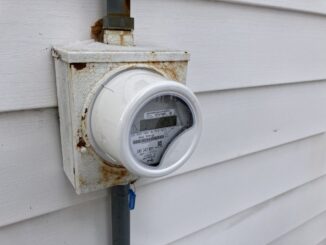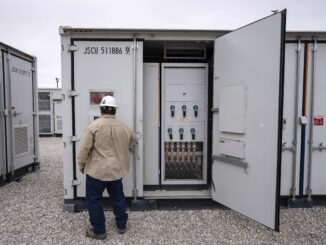
This story was originally published by MinnPost.
Hibbing is something of a rarity when it comes to electricity. Since 2021, most of the city’s power has been generated by burning wood chips and mulch — up to 9,000 tons a month — largely from a local pallet manufacturer. The plant allows the small municipal utility to support northeastern Minnesota’s logging industry and also avoid buying electricity from large for-profit companies.
“The independence of the city is something that is very important to our ratepayers and that’s why we have the lowest cost of energy of anybody in the area,” said Luke Peterson, general manager of Hibbing Public Utilities.
And because state law counts biomass as renewable energy, Hibbing has likely already met a newly updated goal for 55% renewable electricity more than a decade before a 2035 deadline.
But the plant, and the city, is now in limbo. A landmark climate law passed in February by Democrats who control the Minnesota Legislature requires electric utilities to be 100% carbon-free by 2040. And the regulations do not say whether a renewable wood-burning plant will be considered carbon-free.
Sign up for Energy News Weekly
Get the most important energy news of the week delivered directly to your inbox.
It’s a conundrum that could force Hibbing to find new power sources. It also illustrates how smaller utilities in Minnesota are grappling with the carbon-free standard, which has been a fierce point of political debate at the Capitol.
While large, investor-owned utilities like Xcel Energy that serve big cities are often the main focus of attention in the shift away from fossil fuels, cooperative and municipal utilities will need to hit carbon goals, too.
At least one city, Moorhead, says it’s already effectively at 100% carbon-free power. Hibbing, on the other hand, could be at zero. Leaders at both city utilities praised the progress toward cleaner power, but they also had frustrations with the DFL plan.
Political debate arises over smaller utilities
Democratic lawmakers tried for years to pass a bill steering electric utilities toward a 100% carbon-free grid, arguing it is crucial to prevent the worst impacts of climate change.
After winning full control of Minnesota’s government in the 2022 elections, they wasted little time in making that dream a reality. Despite cries from Republicans that DFLers were moving too fast, the House and Senate approved the measure two weeks after its first hearing.
While large, for-profit utilities like Xcel Energy and Minnesota Power generate and distribute much of the state’s electricity, 1.7 million Minnesotans are served by nonprofit electric cooperatives and another roughly 391,000are served by municipal utilities.
Under the law, smaller utilities will need to be 60% carbon-free by 2030, 90% by 2035 and then 100% in 2040. The bill does include “off ramps,” which allow a utility to ask the state’s five-member Public Utilities Commission to let it break standards if it can’t meet those benchmarks without risking affordability or grid reliability. Electric utilities also can buy energy credits to offset their use of carbon-emitting power.
There are more than 120 municipal electric utilities in the state — from Ada to Worthington — serving primarily cities in Greater Minnesota. Many have joined together with other city utilities in bigger electric systems known as “power agencies.”
As lawmakers debated the 100% bill, Republicans questioned whether the state should move ahead if cooperative and municipal utilities had issues with the bill.
In late January, Gov. Tim Walz told reporters that the Legislature should “bring folks along” when asked if there should be consensus with the smaller utilities. “We’ll get them on board,” he said.
Four days later, Kent Sulum, director of government relations and senior counsel for the Minnesota Municipal Utilities Association, testified at a Senate hearing that the organization wasn’t opposed to the concept of the bill. But he said municipal utilities had “serious concerns” about the feasibility of reaching 100% carbon-free energy.
“Some of the initial studies show 80% is a doable figure,” Sulum said. “After that, things get very murky and very expensive.”
Sulum said many city utilities only generate power in times of emergency or to pump extra power into the regional grid when demand is high. But under the new law, Sulum said those utilities would have to buy credits or clean power that will be “greatly expensive” for small communities.
“The cost is higher,” Sulum told MinnPost. “You don’t have shareholders to pass it along to.”
Backup diesel is one question
One of those small utilities is in Princeton, home of Republican Sen. Andrew Mathews, who said during the Senate floor debate before the bill passed that Xcel Energy is the “least likely entity” to ask the PUC for an “off ramp” exception. The large utility already has a huge source of carbon-free nuclear power, for instance, when new nuclear is off limits to others because of a moratorium in Minnesota.
Keith Butcher, the general manager of Princeton Public Utilities, said the city gets electricity through the 18-member Southern Minnesota Municipal Power Agency, which in 2020 announced it planned to be 80% carbon-free by 2030.
But Princeton also has roughly 12 megawatts of diesel power. The newest generator was designed as a marine engine for use on a cruise ship, Butcher said.
Butcher said that diesel can be used if the city was somehow cut off from electric transmission. In fact, the use of generators in Princeton dates back to the 1930s, when there were fewer transmission lines and those lines were less reliable.
Now, however, the diesel is mainly for periods of high demand, when the regional grid operator Midcontinent Independent System Operator — known as MISO — asks for help keeping up energy supply across its interconnected market.
Butcher said Princeton ran diesel during two polar vortexes in recent years. In one, the diesel generators operated for more than 30 hours straight. He said diesel and other similar fossil fuel production may be a small percentage of electricity produced, but in times of extreme cold or heat when the grid needs support, they’re really important for “broader, societal” grid stability.
Are there alternatives to diesel?
Perhaps. Yet Butcher said there are downsides to other options, like a lack of available hydro or the intermittent nature of wind and solar, especially in extreme weather. “If you’re saying you want us to be 100% (carbon-free) at 3 a.m. on Jan. 21 when the temperature is -21 degrees out, I don’t know how to do that,” Butcher said.
Two utilities are far ahead of climate goals
There are municipal utilities, however, that are close to 100% carbon-free energy, or believe they are already in compliance with the state’s 2040 goal.
That includes Moorhead and Detroit Lakes, which are in the district of DFL Sen. Rob Kupec. During the same Senate floor debate, Kupec used the cities as examples of why he would vote for the bill. “This is doable,” he said.
Moorhead Public Service gets about 53% of its electric power, most of it directly from hydro through dams on the Missouri River, a resource not broadly available across the state. Their allocation comes from a federal wholesaler called the Western Area Power Administration.
The rest of the city’s electricity mix is provided by the power agency Missouri River Energy Services, which also has some carbon-free electricity. In total, the electric power supply for Moorhead Public Service is about 85% carbon-free.
Travis Schmidt, general manager of Moorhead Public Service, said the utility buys renewable energy credits to cover the remaining 15% because they have been cheap in recent years. “We are 100% net-zero carbon power supply,” he said, already meeting the 2040 mandate.
Detroit Lakes has a power supply that is 80% carbon-free, said utilities general manager Vernell Roberts. That’s also thanks in part to a large allocation of hydropower from the Missouri River. “We value that WAPA allocation dearly,” Roberts said.
Both Moorhead and Detroit Lakes also have a large share of power from what they describe as “market purchases.” Those purchases include fossil fuels, but the emissions count only against the seller, not the buyer, the officials said, so in their view the cities can deem the electricity as carbon-neutral.
The legislation does factor in the level of carbon emissions in purchases from MISO, however.
Still, Roberts and Schmidt had concerns about the 100% standard. Schmidt said he worries the price of energy credits will rise dramatically as demand for them grows because of the climate law.
But, like Butcher from Princeton, Schmidt said he worried generally about the stability of the whole grid as large plants that generate consistent energy from coal and natural gas are retired.
Detroit Lakes even published a letter urging lawmakers to slow down and rethink the 100% bill as it moved through the Legislature. Roberts said he believes the grid can get to between 80-90% carbon-free energy with new wind, solar and energy storage resources.
But he said storage projects could take a tremendous amount of time. For instance, he said Missouri River Energy Services has proposed pumping water uphill using renewable power like solar and wind to store it for release during periods of high electricity demand, an idea Roberts said could take up to 20 years to get permitted and built.
Roberts also said he’s concerned the market won’t build wind and solar, or transmission lines to carry it, fast enough to meet demand given retiring fossil fuel plants and higher demand from things like electric vehicles and heat pumps.
Hibbing in limbo, hoping for clarity
Hibbing is not part of a power agency, but instead runs independently. Peterson, the utility’s general manager, said city residents like the multiple benefits the biomass plant can bring.
For instance, Hibbing is not as connected to larger electric markets that can spike prices during events like a polar vortex. The city first opened the wood-burning plant in 2007 as part of a deal with Xcel Energy for storing nuclear waste in the state. But it was idled for three years because Xcel, which bought power from the Hibbing plant, said the electricity was too expensive.
The city re-started operations for its own customers in 2021, after an extreme cold snap led to higher gas prices. In addition to its electricity output, the plant produces heat for about 1,000 customers. Most of that heat is used by hospitals, schools and large public buildings.
Peterson said Hibbing is also free from the profit-driven model of other utilities and can bring value to the region through buying wood waste. He said some movement toward 100% carbon-free energy “is better than none.” But Peterson, too, had gripes about the bill, which he said was more geared toward those larger utilities that can build infrastructure and recoup costs from ratepayers. He also said lawmakers didn’t take a closer look at the upside of systems like in Hibbing. And Peterson argued other countries, like Finland, have relied heavily on biomass to reach its climate goals.
But the biggest question mark for Hibbing is whether their biomass will ultimately be considered carbon-free or carbon-neutral.
House Majority Leader Jamie Long, a DFLer from Minneapolis who was prime sponsor of the 100% bill in the House, said lawmakers intentionally did not weigh in on whether a wood burning plant should be considered carbon-free.
He wanted to give the PUC flexibility to determine what meets the climate standards since the commission regulates the electric sector in Minnesota and has expertise on the matter. The law can give a utility partial credit for carbon-free power, however, meaning if the PUC decided a technology was 95% carbon-free, that utility would need to offset less through buying energy credits.
Asked if he considered the Hibbing plant to be carbon-free, Long said: “That’s an important question for the Public Utilities Commission.”
“I think that it would probably be something that would depend on the source material and how it’s produced,” Long said. “You do have carbon coming out at the end from burning wood. So it would be a question of whether or not a utility wants to make an argument that there is a sink on the other side and that is therefore a carbon-reducing or carbon-free technology.”
Peterson, meanwhile, said he hopes legislators tweak the law. “I’m trusting our state policymakers to make clear that biomass is net-zero,” he said.



